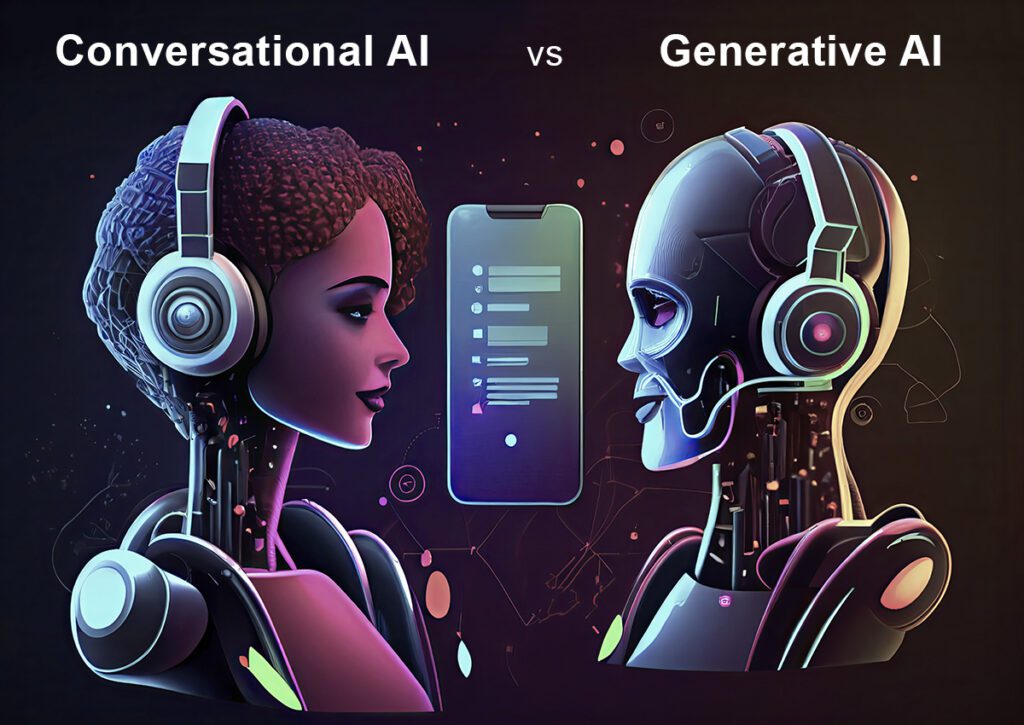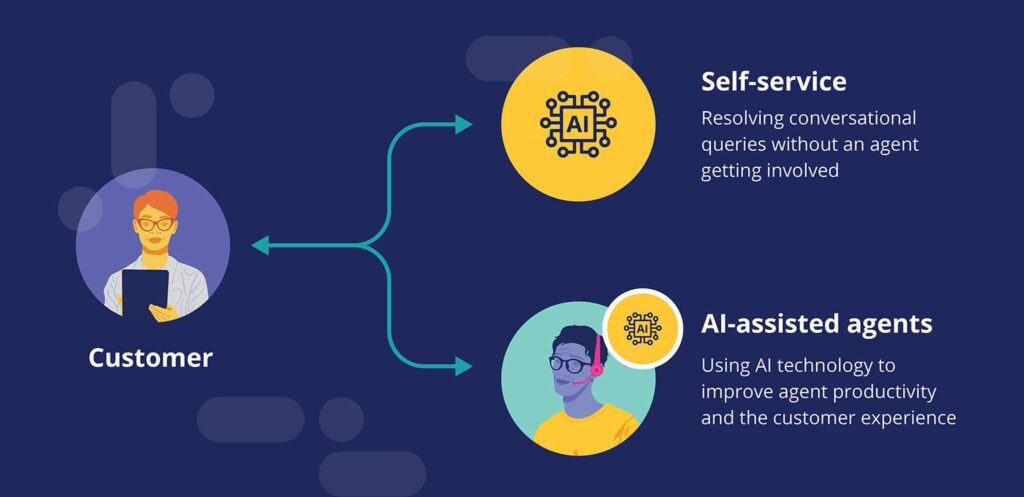What is conversational AI? Conversational AI (conversational artificial intelligence) is a type of AI that allows computers to understand, process, and generate human language. Conversational AI primarily takes the form of advanced chatbots.

What is Conversational AI definitions?
Conversational artificial intelligence (AI) refers to technologies such as chatbots and virtual agents that allow users to interact. They use large amounts of data, machine learning, and natural language processing to mimic human interaction, recognize voice and text input, and translate its meaning into different languages.
Conversational AI is enabled by technology that senses, responds to, and learns from customer conversations. Chatbots and virtual assistants use natural language processing (NLP), machine learning (ML), voice detection, and more to help customers reach solutions quickly through all-natural communication over the phone, website, or messaging channels. . So we will support you in doing so.
This also applies to AI-powered tools that act as co-pilots, guiding real agents and enabling them to better engage with customers. By eliminating manual tasks, agents can focus on what really matters: providing a faster, more personalized customer experience.
How does conversational AI work?

Conversational AI examples
Pega’s Intelligent Virtual Assistant (IVA) is an example of conversational AI within the Pega PlatformTM. IVA allows businesses to create and deploy AI-powered virtual assistants to connect with customers and users through a variety of channels, including websites, mobile apps, and messaging platforms.
For example, businesses using Pega’s intelligent virtual assistants can implement virtual customer service representatives to assist customers with inquiries, troubleshoot problems, and provide information.
Are chatbots and conversational AI the same thing?
No, conversational AI and chatbots are not exactly the same, but they are related. Conversational AI is a broad term that refers to technology that enables machines to understand, interpret, and respond to human language. Chatbots are one of the most common applications of conversational AI, using natural language processing (NLP) and machine learning (ML) to simulate human conversations and provide automated assistance to customers.
Components of Conversational AI
Conversational AI combines natural language processing (NLP) and machine learning. These NLP processes flow in a continuous feedback loop with machine learning processes to continually improve AI algorithms. Conversational AI has fundamental components that allow it to process, understand, and generate responses in a natural way.
Machine learning (ML) is a subfield of artificial intelligence consisting of a set of algorithms, features, and datasets that continually improve with experience. As input increases, AI platform machines become better at recognizing patterns, which they use to make predictions.
Natural language processing is the current method of analyzing language using machine learning, used in conversational AI. Before the advent of machine learning, language processing methods evolved from linguistics to computational linguistics to statistical natural language processing. In the future, deep learning will further advance the natural language processing capabilities of conversational AI.
NLP consists of four steps: input generation, input analysis, output generation, and reinforcement learning. Unstructured data is converted into computer-readable format and analyzed to generate appropriate responses. The built-in ML algorithm improves response quality as it learns over time. These four NLP steps are explained in more detail below.
Input generation: The user provides input through the website or app. Input can be in the form of audio or text.
Input analysis: When input is text-based, conversational AI solution apps use natural language understanding (NLU) to understand the meaning of the input and derive its intent. However, if the input is speech-based, use a combination of automatic speech recognition (ASR) and NLU to analyze the data.
Interaction management: In this phase, Natural Language Generation (NLG), a component of NLP, generates responses.
Reinforcement learning: Finally, machine learning algorithms refine feedback over time to ensure accuracy.
More Related Topics:
- What is artificial intelligence (AI)? How many types of AI are there, and how many courses are in AI?
- What is artificial intelligence? Definition, top 10 types and examples
- What is natural language processing?
- What is artificial intelligence? Definition, top 10 types and examples
- What is deep learning?
- Top 10 Best Topics for Research in Artificial Intelligence
How to Create Conversational AI
Conversational AI starts with thinking about how potential users want to interact with your product and what their key questions might be. Conversational AI tools can then be used to help access relevant information. This section explains how to get started planning and building conversational AI.
1. Find a list of frequently asked questions (FAQs) for end users.
FAQs are the foundation of the conversational AI development process. These help define the primary needs and concerns of your end users, resulting in somewhat reduced call volume to your support team. If your product doesn’t have an FAQ list available, start working with your customer success team to determine an appropriate list of questions that conversational AI can help with.
For example, let’s say you’re a bank. Here is the first list of frequently asked questions:
- How do I access my account?
- Where can I find my routing number and account number?
- When will I receive my debit card?
- How do I activate my debit card?
- How do I order a check?
- How can I talk to a local banker?
You can add questions to the list at any time, so start with a small section of questions to prototype your conversational AI development process.
2. Use FAQs to Develop Goals for Conversational AI Tools
FAQs form the basis of the goals or intentions expressed in the user’s input, such as accessing an account. Once you’ve outlined your goals, you can include them as intentions in a powerful conversational AI tool like WatsonX Assistant.
From here, you need to teach your conversational AI how to express or ask for this type of information. Examples of “how to access your account” include “how to log in,” “how to reset your password,” “how to sign up,” and other information users can use when chatting with a support representative. A phrase may come to mind. for accounts, etc.
If you’re unsure about other phrases your customers might use, we recommend working with your analytics and support teams. When chatbot analytics tools are properly configured, analytics teams can mine web data and infer other queries from site search data. Or you can analyze transcript data from web chat conversations or call centers. If your analytics team isn’t prepared to handle this type of analysis, your support team can also provide valuable information about common ways customers express their questions.
3. Use objectives to understand and generate relevant nouns and keywords.
Think about the nouns or entities that surround your intention. This example focuses on a user’s bank account. As a result, it makes sense to create an entity for bank account information.
This category of information can contain many values, such as “username,” “password,” and “account number.”
To understand the entities associated with a specific user’s intent, you can use the same information you collect from your tools and support team to create goals and intents. These nouns are placed before or after the main question.
4. Bring it all together to create meaningful conversations with your users
All of these elements work together to create an interaction with the end user. Intents allow machines to understand what a user is requesting, and entities serve as a means to provide relevant responses. For example, imagine the following conversation between a conversational AI and a user who has forgotten his password.
Goals and nouns (or intents and entities, as IBM prefers) work together to create a logical conversation flow based on the user’s needs. If you’re ready to start building your own conversational AI, you can try IBM’s WatsonX Assistant Lite edition for free.
Conversational AI Use Cases
When we think of conversational artificial intelligence, we often think of online chatbots and voice assistants for customer support services and omnichannel deployment. Most conversational AI apps include extensive analytics in their backend programs to help ensure a human-like conversation experience.
Experts believe that current applications of conversational AI are weak because they focus on performing tasks in a very narrow area. Strong AI is still a theoretical concept, focusing on human-like consciousness that can solve a variety of tasks and solve a wide range of problems.
Despite its narrow focus, conversational AI is a very attractive technology for businesses and can help increase their profitability. AI chatbots are the most common form of conversational AI, but there are many other use cases throughout the enterprise. examples include:
- Online Customer Support: Online chatbots are replacing human agents in the customer journey. They answer frequently asked questions (FAQs) on topics like shipping, provide personalized advice, cross-sell products, make size suggestions for users, and help you think about customer engagement on websites and social media platforms. Let’s help. I will change it. Examples include messaging bots on e-commerce sites that use virtual agents, messaging apps like Slack and Facebook Messenger, and tasks typically performed by virtual or voice assistants.
- Accessibility: Businesses can become more accessible by lowering barriers to entry, especially for users of assistive technology. Conversation AI features commonly used by these groups are text-to-speech dictation and language translation.
- HR processes: Many HR processes can be optimized using conversational AI, such as employee training, onboarding processes, and updating employee information.
- Healthcare: Conversational AI will make healthcare services more accessible and affordable for patients, while improving operational efficiency and making administrative processes like claim processing more streamlined.
- Internet of Things (IoT) devices: Most homes now have at least one IoT device, from Alexa speakers to smart watches to cell phones. These devices use automatic speech recognition to interact with end users. Popular apps include Amazon Alexa, Apple Siri, and Google Home.
- Computer software: Conversational AI simplifies many tasks in an office environment, such as search autocomplete and spell checking when you search something on Google.
Currently, most AI chatbots and apps have rudimentary problem-solving skills, but they can reduce the time and cost efficiency of repetitive customer support interactions, freeing up human resources to focus on more complex customer interactions. Overall, conversational AI apps do a good job of mimicking the human conversation experience, which improves customer satisfaction.
Benefits of Conversational AI
Conversational AI is a cost-effective solution for many business processes. Here are some examples of the benefits of leveraging conversational AI.
Cost efficiency
Staffing a customer service department can be quite expensive, especially when trying to answer questions outside of normal business hours. Providing customer support through a conversational interface can reduce business costs related to payroll and training, especially for small and medium-sized businesses. Chatbots and virtual assistants can respond instantly, allowing you to be available to potential customers 24 hours a day.
Human conversations can also result in inconsistent responses to potential customers. Since most support interactions are information-seeking and repetitive, businesses can program conversational AI to handle different use cases and ensure extensibility and consistency. This creates consistency in the customer experience and frees up valuable human resources to address more complex questions.
Increase sales and customer engagement
As mobile devices are introduced into consumers’ daily lives, businesses must be prepared to provide real-time information to end users. Conversational AI tools are more readily available than human employees, allowing customers to engage with your brand faster and more often. This quick assistance helps customers avoid long waits at call centers and improves the overall customer experience. As customer satisfaction increases, companies will see effects in the form of increased customer loyalty and increased referral revenue.
Personalization capabilities within conversational AI also give chatbots the ability to provide recommendations to end users, allowing businesses to cross-sell products that customers may not have originally considered.
Scalability
Conversational AI is also highly scalable, and adding infrastructure to support conversational AI is cheaper and faster than onboarding. This is especially useful when your product expands into new geographic markets or during unexpected short-term increases in demand, such as during the holiday season.
Conversational AI Technology Challenges
Conversational AI is still in its infancy, having only begun to be widely adopted in business in recent years. Like any new technological advancement, the transition to conversational AI applications presents many challenges. examples include:
Language input
Linguistic input can be a problem for conversational AI, whether the input is text or voice. Dialects, accents, and background noise can affect AI’s understanding of raw input. Slang and unscripted language can also cause problems with input processing.
However, the biggest challenge for conversational AI is the human element in language input. Emotion, tone, and sarcasm make it difficult for conversational AI to interpret the user’s intended meaning and respond appropriately.
Privacy and Security
Because conversational AI relies on data collection to answer user questions, it is also vulnerable to privacy and security breaches. Developing conversational AI apps and monitoring systems with high privacy and security standards can help build trust among end users and ultimately increase chatbot usage over time. I can do it.
User Concerns
Users may feel concerned about sharing personal or sensitive information, especially if they realize they are talking to a machine rather than a human being. Not all customers will be early adopters, so it is important to educate and engage your target audience about the benefits and security of these technologies to create a better customer experience. This can degrade the user experience, degrade AI performance, and negate any positive effects.
Additionally, chatbots cannot be programmed to respond to detailed user inquiries. In that case, it is important to provide alternative communication channels to address more complex questions, as end users may become frustrated if given incorrect or incomplete answers. In such cases, customers should be given the opportunity to contact a human representative of the company.
Finally, conversational AI could optimize workflows within companies, reducing the workforce for certain jobs. This could have a negative impact on socio-economic activity and businesses.
follow me : Twitter, Facebook, LinkedIn, Instagram

3 thoughts on “What is conversational AI? 7 best features, Definition, and examples”
Comments are closed.